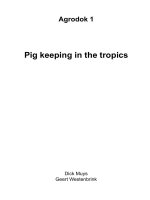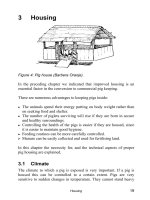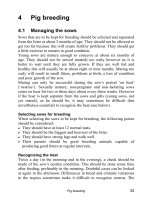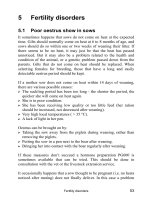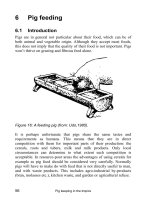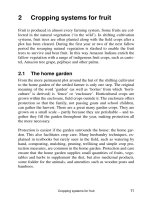Erosion control in the tropics - Part 7 pptx
Bạn đang xem bản rút gọn của tài liệu. Xem và tải ngay bản đầy đủ của tài liệu tại đây (297.7 KB, 17 trang )
Erosion control in the tropics 56
7 Measures to reduce runoff
Often technical measures against erosion are not very beneficial in
themselves. They should go hand in hand with cultivation methods
and good guidance. An important question is whether the farmer him-
self can pay for the operations and/or execute them.
The purpose of technical measures is to prevent water causing dam-
age. This can be done by making better use of the available water for
the crop (water conservation) and/or by controlling the runoff water.
These subjects are covered in this chapter.
Another way is to develop a drainage system through which the run-
off-water is collected and diverged before it reaches the agricultural
land. Damage done by the uncontrolled runoff is then avoided. Drain-
age systems are explained in chapter 8.
7.1 Different levels of measures
The catchment area is the area from which the runoff contributes to
the discharge at a certain point in a stream or river. The borders of this
area are determined by the so-called watersheds, the tops of the sur-
rouding hills. This means the farther downstream, the larger the
catchment-area and the larger the flow in the stream. Further, the scale
determines clearly the extend of the measures to be taken. This seems
obvious, however, it determines a principle aspect of the problem. The
number of people involved and therefore the level of cooperation.
The people in the flood-prone areas will have most problems, whilst
the basic measures for prevention have to be taken mostly farther up
in the hills. So, not only can we distinguish here between different
methods, but it is also important to consider the level and the scale on
which the measures are taken. This can be at:
? farm level,
? slope level or
? watershed level (see figure 20).
Measures to reduce runoff 57
Figure 20: Catchment areas
All measures will need regular maintenance in order to be effective in
the long run.
Farm level
At farm level the starting point is that the land is used according to its
potential. This is not always the case because of all sorts of other
(socio-economic) factors (see Chapter 8). Technical measures at farm
level can be carried out by the farmer himself, perhaps with some as-
sistance from colleagues. Contour farming is simple but effective to
apply (see Chapter 5).
To determine the contour lines, see appendix 1 in which some survey-
ing techniques are briefly described. Further information can be found
in Agrodok 6: ‘Simple Construction Surveying, for Agricultural Prac-
tices’.
Slope level
At slope level as well as at farm level, work is carried out as far as
possible from top to bottom (starting lower down involves the danger
that operations carried out are destroyed by flood water and mud
streams from higher up). The slopes should be well drained, for which
diversion ditches are needed.
Erosion control in the tropics 58
Gully formation will have to be kept in check too, if necessary (see
also 7.5). Serious gullies and ravines are often found in areas with
deep soil profiles and steep slopes. The type of precaution taken to
check such gullies depends on their size, the extent of the drainage
system and catchment area and the anticipated peak runoff (see glos-
sary). Smaller gullies can usually be kept in check by the farmer him-
self.
At slope level, the size of the operations generally determines whether
a farmer can take action single-handed or together with a few col-
leagues. However, depending on the nature and magnitude of erosion,
a bigger organization will have to be brought in. Apart from the gov-
ernment this could be a cooperative, a communal or village society. A
central government usually only becomes involved if greater interests
are at stake, for example the silting up of a dam.
Apart from the organization of the recurrent maintenance work, an-
other problem can be the costs and the labour involved. Not only those
who benefit directly from the measures should be responsible.
Watershed level
A watershed level in principle includes both sides of the river and then
erosion control is often part of a (civil engineering) development plan.
Operations carried out at this level include reafforestation, improve-
ment of rivers to prevent flooding in the lower reaches, and also ter-
racing on a large scale (see 7.3). Such a development plan will usually
cost a lot of time and money. Large-scale projects will then have to be
carried out by the government. A well set up water conservation engi-
neering plan for a larger area will make further small scale measures
more effective.
However, depending on the point in the river from where one counts, a
watershed area may be much smaller. So if the problems related to
erosion (flooding, silting up of canals) occurs in a small tributary, the
catchment area will be relatively small as well: perhaps as small as
just the property of a single farmer. In this case the farmer will be able
to, and has to, manage things by himself, for instance by terracing and
lining of susceptible points in the embankment of the river.
Measures to reduce runoff 59
7.2 Barriers to reduce the speed of running
water
Contour farming has already been mentioned (in Chapter 5) as a
measure against erosion. But if the land is very split-up and a continu-
ous strip cannot be worked along the contour, then barriers can be laid
out along the contour to reduce the speed of the run off. These barriers
can be made of living vegetation or stones. Some farmers use plant
residues such as maize stalks etc.
These barriers reduce the speed of the runoff and prevent the soil to be
carried away by runoff-water. The soil carried along, piles up before
the barrier (Figure 21). Gradually terraces are built up which keep ero-
sion under control. As the slope decreases (division into terraces) the
velocity of the running water is reduced and the chance of erosion is
less. These measures are only suitable on gentle slopes.
Figure 21: Terrace formation by vegetation line or stone bund
On the terraces the superficial runoff water is controlled and collected.
The water can infiltrate into the soil (water conservation). See also
Agrodok no 13: Waterharvesting and soil moisture retention.
Banks or walls can be strengthened by stakes, fastened together by
liana or rope for example (Figure 22). Damage of the stakes by ter-
mites may be a problem here.
Erosion control in the tropics 60
Figure 22: Strengthening of a bank
Planning of the work
Make sure that you choose the right measure to control erosion. Try
on a smaller area before you apply the measure for a large area, or
look for experiences of other people.
In order to make a good plan of operations it is important that good
preparations have been made. Materials should be ready and enough
labour available. Make sure you choose the right season.
7.3 Terraces
Terracing is a very effective measure against erosion. Terraces are
more or less horizontal beds on the slope, laid out along the contour
(Figure 23). The purpose of terracing is to prevent water flowing too
quickly over a sloping field, and thus minimize the risk of erosion.
This can be done by collecting the superficial runoff water on the
slope and then let it infiltrate into the soil. Through terracing on
steeper slopes the area for cultivation can be increased or improved.
There are a variety of terraces, depending on the way they are built or
on their function. The different types will be explained. Earthen ter-
races are most frequently used. This type and other types of terraces
are explained below.
Measures to reduce runoff 61
Figure 23: Terraces (source: FAO)
Earthen terrace
One possibility is an earthen terrace. The farmer can lay this out him
or herself, perhaps with some help from neighbours, using a plough,
hoe or spade. This is precision work however, which requires experi-
ence and knowledge. Earthen terraces are the simplest kind of terrace
and are the most common in hilly regions.
Earthen terraces seem simple to make by oneself, but we advice to ask
help from an expert because if terraces are not made properly, they
might collapse in a hard rainstorm. The damage then will be worse
than normal erosion and hardly to recover. A schematic diagram of
such a terrace is figure 24.
Figure 24: Terrace with up-slope drain
Along the terrace a channel for drainage is laid out, in order to dis-
charge quickly of too much water in a heavy rainstorm. In dry areas
Erosion control in the tropics 62
the terrace drain is often laid out down-slope (as in figure 25) because
there is not such a danger of silting up here as in wetter areas. In wet-
ter areas the drainage channel is laid out up-slope, as in figure 24. This
will reduce the risk of serious damage to the fields by a breakage in
the earthen bund during a heavy run-off.
Figure 25: Outline of an earthen terrace
Width of the terrace
The width of the terrace depends on the steepness of the slope. Table 2
gives the measurements of the width of a terrace according to the
slope percentage. Local conditions such as soil type and rain intensity,
of course influence these measurements.
Table 2: Width of a terrace according to the slope percentage
Slope (z/x * 100%) Terrace distance (x)
1% 40 - 60 m
2% 20 - 40 m
6% 15 - 30 m
10% 10 - 20 m
40% 5 - 10 m
If the slope percentage (see glossary) is 40% or more the terrace will
be very small. Much labour is required for laying out, which is expen-
sive. If such a slope does not have to be used for cultivation of crops,
Measures to reduce runoff 63
a permanent vegetation might be considered such as woodland, fruit
trees, tuft-forming plants or suchlike (see Chapter 6).
Length of the terrace
The length of the terrace (that is, parallel to the contour) will of course
vary according to the local situation, obstacles, land ownership etc.
The terrace drain should not be too long because of the danger of
scouring out. A solution to this is to incorporate cross ties in these
drains at regular intervals. If runoff is not too much the velocity of the
water is reduced and the water can infiltrate (Figure 26). You will of
course have to calculate or experience whether the drain capacity is
adequate to take all the water.
Figure 26: Terrace drain with cross-ties
Absorption terraces
Apart from preventing erosion, absorption terraces have an extra im-
portant function: water conservation. These terraces collect runoff wa-
ter after a rainstorm, store it up temporarily and then let it infiltrate
into the soil.
This type of terrace is especially beneficial in fairly dry areas where
there is often a water shortage. As much water as possible can then be
collected in the sporadic and sometimes very heavy showers that do
occur.
Erosion control in the tropics 64
The soil surface should be fairly rough here so that the greatest possi-
ble infiltration surface is obtained (see figure 11). For less penetrable
soils (such as heavy clay for example) and at very high peak runoff
these terraces are less suitable.
In contrast to normal terraces, absorption terraces are horizontal or
slope slightly backwards. Absorption terraces can best be laid out in
one operation (see figure 27).
Figure 27: Absorption terrace
Drainage terraces
The purpose of a drainage terrace is to safely transport the runoff wa-
ter from a field situated on a slope. Drainage terraces have a slight
slope parallel to the contour line (see glossary: longitudinal slope).
See figure 28.
Figure 28: Drainage terrace
Depending on the expected peak runoff, type of soil and length of the
terrace (catchment area) the slope perpendicular to the contour line is
Measures to reduce runoff 65
between 0.2% and 1%. The water will run down side ways. At regular
distances drains carry away the runoff water preventing too much wa-
ter concentrating in the terraces which could cause bursting or flood-
ing. These secondary drainage canals diverge into a main drainage
system or a gully. See the next paragraph about drainage systems.
7.4 Drainage
An essential preventive measure against erosion is the design, devel-
opment and maintenance of a good drainage system for the catchment
area. The excess water has to be spilled in a controlled way. As ex-
plained in section 7.1, drainage also has to be implemented at different
levels, from catchment level to terrace level.
The principle of a good drainage system is that the large quantity of
water suddenly released by a rainstorm, is discharged quickly and
safely. This means that the ditches and overflows should have a capac-
ity for heavy rainstorms, which do occur only once in about 20 years.
A drainage system consists of several types of drains with different
functions (See figure 29):
Figure 29: Drainage system
Erosion control in the tropics 66
When designing and making a drainage system the rule is to work
from bottom to top, that is: start with the main drain at the bottom so
that the amount of water flowing into the drainage system at a given
time can be led away in a controlled way. If you start at the top a gush
of water may suddenly come down (in the up-stream area water flows
away quickly) whereas the lower area of the drainage system is unable
to cope with it. Because of the large quantity of water accumulating
here, the catastrophe (gully formation, flooding) is soon complete.
Main drain
The main drainage serves as the main channel where all the water is
collected.
? One main drain at the bottom of the catchment area: all the col-
lected water ends up in the main drain which then leads it to a river
or so.
? Several secondary drains, which serve to collect the water from a
larger area within the catchment area.
? Collecting drains, which can be drains from drainage terraces (see
7.3) or diversion ditches.
The size and shape of the main drain should be adequate to accommo-
date a large quantity of water flowing through in a short period of
time. For main drainage, large natural drains, canals or stabilized gul-
lies are used.
Secondary drain
The secondary drainage consists of fairly wide discharge drains to
carry away surface water to the main drainage. These drains are often
artificially laid out and planted up with grass for example (they are
referred to as grassed water ways). The grass protects them against
damage from scouring water. These drains only carry water during
peak runoff, otherwise they are usually dry.
Collecting drain
The collecting drains of a terrace (especially the collecting drains) dis-
charge their surplus water into the secondary waterways. Water from
an established drainage system will flow in here too.
Measures to reduce runoff 67
Diversion ditch
A diversion ditch is a ditch on the upper side of good agricultural land
that lies at the foot of steeper slopes. The runoff from up hill is col-
lected in the ditch and regulated toward a gully. The soil excavated
from the ditch forms a ridge down slope. Preferably this ridge is
planted with grass or other vegetation to secure it (Figure 30).
Figure 30: Diversion ditch
A diversion ditch is often a good starting point for controlling erosion.
The collecting drain should not slope too much lengthwise (to 1%)
otherwise these drains are themselves damaged by the high flow ve-
locity. Regular maintenance is also very important to prevent the
drains from silting up. If a drain gets blocked you can imagine the
problems that follow. These problems can best be prevented by ensur-
ing that no soil material or dirt gets into the diversion ditch.
7.5 Gully control
Gully formation may be severe in areas with deep soils and steep
slopes. On steep slopes the velocity of the water is very high and the
scouring effect will be great. A deep soil profile with only little cohe-
sion is susceptible to rapid and deep gully formation during heavy
rainfall.
Erosion control in the tropics 68
The purpose of gully control is not so much erosion control as an at-
tempt to limit the effects of erosion that is taking place up-stream from
the gully. Of course, existing gullies should be prevented from devel-
oping further. What measures are taken to prevent or control the proc-
ess of gully formation depends on the size of the gully and the area to
be drained (the amount of water to be diverged).
First of all we try to check the amount of water coming into the gully
by protecting the soil upstream or even by diverging the water. The
velocity of the water in the gully also has to be checked so that it
doesn’t scour out further.
The farmer himself can keep smaller gullies in check as follows: as far
as possible the water is kept in the middle of the gully so that the walls
cannot be undermined. In shallow gullies small dams with an over-
flow can be laid out with rubble, twigs, stones and wire bolsters. The
water can then ooze through these fairly open constructions whereas
any transported silt is held back upstream. In this way the longitudinal
slope is reduced and with it the flow velocity too.
Figure 31: Controlling smaller gullies: view from above
Measures to reduce runoff 69
If available, wire netting supported by wooden posts, can be used for
smaller gullies (Figure 31). For larger gullies small stone dams can be
used. (Figure 32).
Figure 32: Strengthening of a gully
Checkpoints for making dams
When laying out these check dams, the following points should be
taken into account:
? The principle is to shorten the length of the slope in the gully over
which the water flows, so that the flow velocity (and with it the
chance of further erosion) decreases.
? The gully walls at the position of the dam and also a part upstream
are graded to a slope of 1:2 (going up 1 meter over a distance of 2
meters) or less, so that the chance of breaking is minimized.
? There should be good contact between the dam and the gully wall
(well anchored); otherwise the temporary structure will wash away.
Fencing poles are always driven deep into the soil so this applies to
these structures too.
? The dam should be lowest in the middle where the flow has to con-
centrate at the overflow.
? The gully floor should be strengthened down stream against the
scouring force of the water. This can be done by making a type of
Erosion control in the tropics 70
mattress or cover which is well sealed. (For example broken stone,
discarded car tires filled up, concrete rubble etc.). After overflow-
ing, the water is very turbulent. Even though the stream is concen-
trated in the middle of the gully, the walls will have to be extra
strengthened (Figure 32).
Obstacles within the gully that force the water to the sides have to be
removed in order to prevent further scouring out of the sides of the
gully.
In certain cases, the turbulence of the water causes undermining of the
head of the gully. This means that the head (starting point) of the gully
cuts in further backwards (up slope), see figure 33. Measures have to
be taken to prevent this happening.
Figure 33: An exemple of undercutting > process over a period of
time
Protection of the head of the gully can be done by protecting the soil
with broken stone, rubble, twigs or similar material. It is also advis-
able to keep the area around the head of the gully planted up with trees
or a tuft-forming crop, for example.
To prevent trampling by cattle (sometimes even the direct cause of
gully formation) preventive measures should be taken by making a
good fence (thorny hedge for example).
By leading the water along the lower parts of the land you must be
sure that water actually comes into the gully.
Measures to reduce runoff 71
7.6 General remarks for technical measures
In the design and execution of mechanical works, the following lay
out directions could be useful:
? The main purpose is and remains to prevent erosion. Other motives
(such as encouraging infiltration or making a reservoir) should not
hinder this objective. This does not mean to say that the main pur-
pose and other goals are contradictory, on the contrary.
? Land use measures are not always necessary. Often a simpler solu-
tion will suffice following the principle of shortening the slope
length to limit the flow velocity. (Crop management techniques
such as strip cropping or contour farming).
? The simpler methods are usually best because there is only a small
chance of failure: Organization is less complicated; the work costs
less; simple measures are often very effective. Adaptation can also
be made after gaining some experience. Large-scale operations in-
volve more risks because more water is involved.
? Mechanical measures (with machines) can only be applied to arable
land, if required, because of the relatively high costs and the danger
of erosion is greater here.
? A plan or measure should always be adapted to the method of exe-
cution: depending on the available manpower for hand labour or
machines; size of operations should be in accordance with the
available equipment (plough or bulldozer, for example).
? As far as possible the works to be carried out should fit into the fu-
ture land development schemes. For example when laying out ter-
races, take into account the size so that still an easily manageable
plot is left over for the farmer. Don’t lay out terraces 30 m wide in a
field 40 m wide, preferably choose 20 or 40 m. There is always
some margin in the measurements of a terrace, make sure that the
terrace is safe.
? Land use measures are potentially dangerous: That is to say without
proper preparation or execution, the damage may only be worse.
Expertise is a must here!
Erosion control in the tropics 72
? Earthen structures, terraces, dams etc. require continuous and scru-
pulous maintenance (see Chapter 9). This essential maintenance can
be made more attractive by growing fruit trees for example which
will literally and figuratively bear fruit if nursed well.
? The design and layout, and the calculation of structures and drain-
age canals require knowledge and experience for which a hydrolo-
gist can be consulted.


